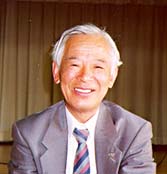Memories of the ABCC Kure Laboratory
by Yutaka Agaoka
Supply Section, 1948-85

Yutaka Agaoka
In the fall of 1948 Kure Laboratory was built at a site just across the street from Kure Kyosai Hospital and relatively close to the center of Kure City. It was a small laboratory which stood on a piece of land about 1,800 square meters in area. Half of the land was occupied by a motor pool. The laboratory had an examination room for internal medicine, an X-ray room, hematology and serology laboratories, a clinic preparation room, a reception office, an administrative office and a few other rooms. A small boiler room and a dispatcher’s office were located just a short distance away from the main building. Approximately 50 people were employed there including foreigners, Japanese doctors and nurses, and the general staff.
In those days, the main laboratory of ABCC was in the Ujina area of Hiroshima City. The foreign staff lived in army billets or large private houses such as Sawahara House and Black House (Miyake House) which had been leased by the occupation forces in Kure, and they commuted from these residences to Hiroshima.
In the days of 1949 and 1950, few motor vehicles other than trucks were on the road. Gasoline was not freely available, and the trucks were powered with gas generated by burning charcoal. In the ABCC Kure Motor Pool there was a fleet of some 10 automobiles: large station wagons, jeeps, a panel truck, and former weapon carriers called “three-quarters.” The station wagons were used for transportation of the US staff between Kure and Hiroshima and the three-quarters were made available to the Japanese staff for commuting to work. This was very much appreciated by the Japanese staff because of the poor public transportation system in those days. The panel truck was used for carrying official papers and mail between the Military Government in Kure and the ABCC Laboratory. The jeeps were used for transportation and contacting of patients, and other official work.
The drivers were all skilled drivers who had passed the rigid ABCC driving test. Many of them had been driving charcoal-driven trucks, and so it was certainly a relief to be freed from the operation of charcoal burners. They were surprised and elated by the high performance of US-made sedans and jeeps, the power the pink-colored high octane gasoline generated, and the quick acceleration at the touch of the foot. The car horns set inside the steering wheel were also very new to us, and I can remember how envious we always felt upon hearing the luxurious sound of the horn and seeing the automobile and the people in it.
In conclusion, I would like to comment on what I think is very important. Soon after the termination of war, we received food from the United States and also vital training in medicine, psychology, machinery, engineering, statistics, and numerous other fields. It is no exaggeration to say that Japan owes its prosperity today to the kindness and generosity of the people and government of the United States. I believe that it is our turn to help the United States when it needs cooperation and support. (Written in January 1988)
This article was originally published in RERF Newsletter 14 (40th anniversary special issue): 10-11, 1988

